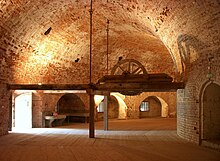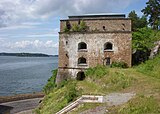Fredriksborg Fortress
Coordinates: 59 ° 24 ′ 1 ″ N , 18 ° 26 ′ 33 ″ E
The fortress Fredriksborg is a fortification in the Värmdö kommun on Oxdjupet at the entrance to Stockholm is located. The fortress consists of a tower , a beach fortification and inner courtyards. The facility was part of the defense that had been built on the Swedish east coast after the Russian devastation in 1719 to protect Stockholm.
The fortress was completed in 1735 and was named Fredriksborg after King Fredrik I. In its time it was one of the strongest fortresses in Europe. In the 19th century the complex fell into disrepair and was replaced by the Vaxholm Fortress . Between 1870 and 1877 another fortress was built opposite Fredriksborg Fortress. This was named fortress Oskar-Fredriksborg . Fredriksborg Fortress is now administered by Statens fastighetsverk and has been a state monument ( Byggnadsminne ) since 1935 .
The first fortress
In 1710, the major of the construction pioneers , Gabriel Cronstedt , suggested building a low-lying redoubt in Värmdö on Oxdjuppet and an additional battery with four 24-pound cannons and a redoubt "up near Värmdö". The aim was to protect the sea entrance to Stockholm. This fortification, which was a little north of today's, was built in the following years. In 1719 the upper redoubt was surrounded by thorny trees and shrubs. All facilities were expanded after the Russian devastation in the years 1720 to 1722.
The second fortress
In connection with the Peace of Nystad after the Great Northern War in 1721, a revision was made by the Swedish armed forces. It was decided to strengthen the defenses on Oxdjupet. After the decision made in 1723, work began on a larger, permanent fortification in 1724. The construction management was again Gabriel Cronstadt and the plans were provided by Quartermaster General Axel Löwen .
The tower
High up, on a level about 40 meters above the water, Löwen placed a colossal, brick tower. This was equipped with a gun and cannon gallery and originally consisted of four floors. The complex was surrounded by a moat and the fortress could only be entered via a drawbridge . The machinery of the old drawbridge is still in its original state today.
The fortress had 40 cannons and accommodated 2,000 men. However, this figure was later questioned by scientists. It is estimated that there were never more than 150 men in the fortress. Fireplaces and a well , which were planned for sieges, were found in the fortress . Around the center there were barracks that were heated by four chimneys .
During this time, such tower constructions were used very often on coastal fortresses. The turret gave the artillery better protection and firepower thanks to cannons installed on different floors that could be aimed at the same target. At the same time, the possibilities of being taken under fire yourself have been minimized. Since the cannons were placed inside the building, there were problems with the powder smoke. Axel Löwen solved the problem by installing high vaults with ventilation openings. The tower was able to protect the beach battery from attacks from the land side.
At the end of the 18th century, the tower of Fredriksborg Fortress was used as a station for an optical telegraph . This was on top of the roof. The telegraph that can be seen there today is a reconstruction of the original.
The beach battery
On the beach there was a beach battery , consisting of a row between two higher structures. The north of these had two and the south three floors. Both roof batteries were provided with a double protective wall between two capons in front of the entrances. Below was a brick water battery with an entrance, the guardhouse and two stone stairs. Today only the northern caponier remains.
In peacetime only about 20 men were stationed at the fortress, while in wartime there were about 150 men. The commanders and crews were initially housed in barracks, but in the 1750s they moved to a barracks building that had been built according to plans by Carl Hårleman . This building has been preserved to this day and is located just above the beach battery.
Work on the fortifications in the Stockholm archipelago came to a standstill after 1740. The reason for this was also that the maintenance of the fortress had been neglected for years and now extensive repair and maintenance costs had to be raised.
The fortress loses its importance
In 1822 the decision was made to demolish the tower, but to strengthen the remaining facilities. In 1826 the Maritime Committee considered the tower a "beautiful architectural work" that no longer had any military features. For this reason, the demolition of the tower was stopped and it was handed over to the naval forces of the time as a beach fortification.
A few years later, the Oxdjupet began to be made impassable for ships. That sealed the end of Fredriksborg Fortress. In the meantime the fortress began to deteriorate. The requested funds for maintenance and repairs were not approved and in 1826 the two capons became ruins. The southern caponier was demolished between 1838 and 1839.
The tower's copper roof was removed in the 1840s, and from 1850 to 1860 many of the sandstones were broken from the outer walls to use to build Vaxholm Fortress . The northern caponier was restored to use it as a shelter for the workers. The tower, which was mainly used as a powder magazine , began to deteriorate more and more. In the end, you tore off its top part. In 1871 the remaining sandstones were used to maintain the Oskar Fredriksborg Fortress on the opposite side of the Oxdjupets.
A few years later the roof of the tower, the lookout and the optical telegraph were reconstructed. The masonry around the entrance was renovated, while large parts of the outer walls remained badly damaged.
Outdoor shots
Indoor shots
Web links
- Entry in the bebyggelseregistret des Riksantikvarieämbetet (Swedish)
Individual evidence
- ↑ a b c d e f g Information about the Fredriksborg Fortress (Swedish) ( Memento of the original from July 30, 2015 in the Internet Archive ) Info: The archive link has been inserted automatically and has not yet been checked. Please check the original and archive link according to the instructions and then remove this notice.
- ↑ a b c d e f g Fredriksborg Fortress (Swedish)
- ↑ a b c Fredriksborg Fortress (Swedish) ( Memento of the original from September 2, 2016 in the Internet Archive ) Info: The archive link was inserted automatically and has not yet been checked. Please check the original and archive link according to the instructions and then remove this notice.
- ↑ Thomas Roth - Swedish history of fortifications (Swedish) ( Memento of the original from August 12, 2010 in the Internet Archive ) Info: The archive link was automatically inserted and not yet checked. Please check the original and archive link according to the instructions and then remove this notice. (PDF; 27 kB)













